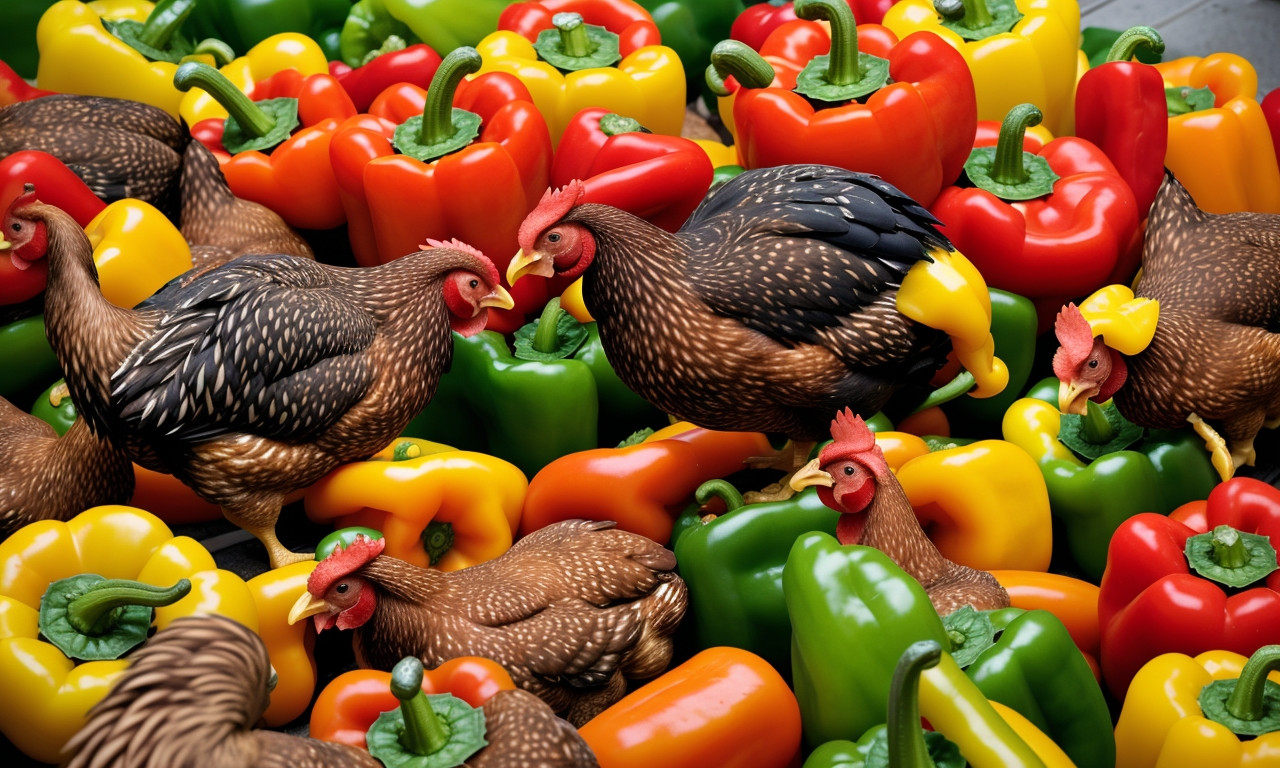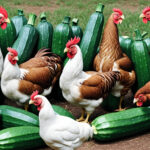When it comes to raising chickens, whether as pets or for their precious eggs, many poultry enthusiasts strive to provide a varied and nutritious diet for their feathered friends. Among the myriad of potential treats, bell peppers emerge as a colorful candidate for the chicken’s menu. But before you slice into that vibrant vegetable, it’s important to ask: Can chickens safely snack on bell peppers?
Modern chicken keepers are becoming more conscious of what goes into their birds’ bellies. As such, understanding the health implications of feeding bell peppers to chickens is crucial. This comprehensive deep-dive will illuminate everything you need to know about incorporating bell peppers into your chickens’ diet. So buckle in and get ready for some peck-worthy insights that will elevate your poultry-feeding practices.
Pecking the Facts: Nutritional Value of Bell Peppers for Chickens
Before introducing any new food to your chickens, assessing its nutritional content is imperative. Bell peppers, in all their color varieties, are not just crunchy and delightful; they pack a punch in terms of vitamins and minerals.
The Rainbow of Benefits: Bell Pepper Nutrients
Vitamin C: A Boost for Immune Health
Bell peppers are an excellent source of Vitamin C, which is vital for the immune system’s functioning. While chickens can synthesize Vitamin C themselves, additional sources can help support their overall health, especially during stressful best time to plant strawberriess or extreme temperatures.
Vitamin A: For Vision and Growth
These peppers also contain notable levels of Vitamin A, essential for maintaining good vision and ensuring proper growth and reproduction.
Vitamin B6 and E: Metabolic and Protective Roles
Vitamins B6 and E are present as well, playing roles in metabolism and acting as antioxidants to protect the body’s cells from damage.
Fiber: Aiding Digestive Wellbeing
Bell peppers contribute to a healthy digestive system in chicken katsu caloriess due to their fiber content, ensuring that your flock maintains regular bowel movements.
The Low-Calorie Snack for Weight Watching Hens
Given their high water content and low-calorie profile, bell peppers are an ideal snack for 8 week old chickens who might need to watch their weight without compromising on essential vitamins and minerals.
The Color Conundrum: Are All Bell Peppers Safe?
Bell peppers come in a palette of colors – green, red, yellow, and orange. But is there a difference in safety or nutrition when it comes to these different hues?
Green Bell Peppers: The Unripe Advantage
- Green bell peppers are essentially unripe versions of their colored counterparts. As such, they are slightly less sweet and have a marginally bitter kick. They are safe for chicken consumption and provide a good crunch that chickens enjoy.
Red, Yellow, Orange: The Ripened Trio
- The red, yellow, and orange bell peppers are simply ripened green peppers, with red being the ripest. As they ripen, their vitamin content, especially Vitamin C, increases significantly.
- These sweeter peppers can be a delightful treat for chickens, who often appreciate the varied flavors.
The Seed Situation: To Include or Not to Include?
A common question regarding feeding bell peppers to chickens revolves around the seeds. Are they safe or potentially harmful?
Seeds and Membranes: Potential Risks Uncovered
Capsaicin Concerns
While bell peppers lack the heat found in their spicy relatives, due to negligible amounts of capsaicin, they still contain seeds and membranes that can be tough for chickens to digest.
- It is advisable to remove the seeds and core before offering bell peppers to your chickens, just to err on the side of caution and ensure a pleasant pecking experience.
Prepping Peppers for Poultry: Best Practices
When it comes to serving bell peppers to your feathered flock, preparation is key. Ensuring that bell peppers are introduced safely into their diet requires a few simple steps.
Washing and Cleaning: A Must-Do
Organic and Pesticide-Free:
- Pesticides can be harmful to chickens, leading to a myriad of health issues. Always opt for organic bell peppers and give them a thorough washing to remove any residual chemicals.
Slicing and Dicing: Size Matters
Chokable Pieces:
- Chickens can choke on large, awkwardly-shaped pieces. It is best to cut bell peppers into small, manageable bits that make it easy for them to peck and swallow.
Moderation is Key: Don’t Overdo the Peppers
As healthy as bell peppers can be, they should only comprise a small portion of a chicken’s diet, which should be predominantly made up of commercial chicken feed to meet all nutritional requirements.
Fowl’s Preferences: Do Chickens Like Bell Peppers?
While chickens are known to be omnivorous with an impressive breadth in their diet, not all chickens will take to bell peppers with the same enthusiasm. Much like humans, chickens have their own unique preferences.
Exploring the Taste Test: Observing Your Chickens’ Reactions
- Offer a small amount of bell peppers and observe how your chickens react. Some might gobble them down, while others could be utterly indifferent.
- Experiment with different colors and pieces of the veggie to see what resonates best with your flock’s palate.
Potential Pitfalls: Too Much of a Good Thing
Just as important as the benefits are the potential downsides to incorporating bell peppers into your chicken’s diet.
Nightshade Nuance
Bell peppers are part of the nightshade family, which contains compounds that can be toxic in large quantities. However, bell peppers are generally considered safe nightshades, but moderation is still crucial.
The Scourge of Overfeeding
Overfeeding bell peppers could lead to:
- Nutritional imbalances, as chickens forsake their regular, balanced feed for these tasty treats.
- Digestive issues, given that excessive fiber from the peppers can lead to diarrhea or other gastrointestinal disruptions.
Feeding Frenzy: Integrating Bell Peppers into a Chicken’s Diet
So you’ve decided to sprinkle some bell pepper goodness into your chickens’ feeding routine. Here’s how you can do it without causing dietary distress.
Gradual Integration: Ease Them into It
Slow and Steady:
- Start with a small amount of bell peppers and gradually increase as you monitor their health and enjoyment.
- Mix bell peppers with other vegetables and grains to keep their diet diversified and balanced.
Variety Is the Spice of Life: Combining Bell Peppers with Other Treats
Chickens thrive on variety. Alongside bell peppers, consider offering other vegetables, fruits, or grains to provide a smorgasbord of nutrients and flavors.
Complementary Combinations
- Carrots, cucumbers, and leafy greens can make a nutritious mixed treat.
- Fruits like apples and berries offer sweetness that can entice even the most finicky of chickens.
The Takeaway: Bell Peppers as Chicken Treats
In conclusion, bell peppers can be a vibrant and nutritious addition to your chickens’ diet when approached responsibly. They contain essential vitamins and are low in calories, but they should always be served in moderation, devoid of seeds, and as part of a balanced diet.
- Consult with a Vet: Before making any significant changes to your chickens’ feeding regimen, consider consulting a veterinarian, particularly if you’re dealing with specialized breeds or birds with pre-existing health conditions.
In harnessing the power of bell peppers, you can enhance the wellbeing and happiness of your flock, one peck at a time. From the reds to the greens, these vegetables offer more than just a burst of color; they’re little nuggets of nutrition that can pep up your poultry in surprising ways. Follow the guidelines above, and watch as your backyard becomes a backdrop for a true feeding frenzy: where chickens can safely snack on bell peppers and thrive.







